Art’s Work in the Age of Biotechnology: Shaping Our Genetic Futures

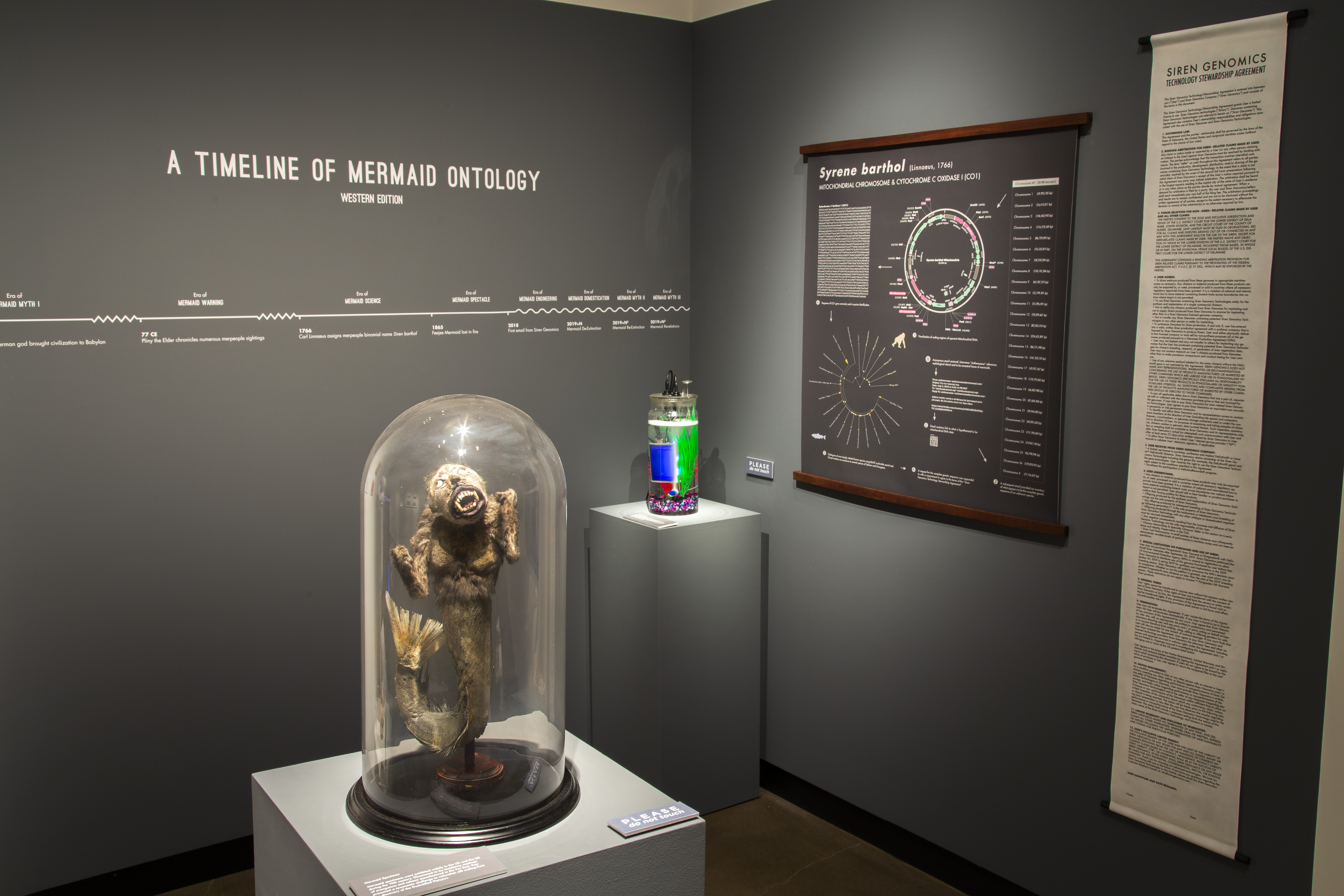






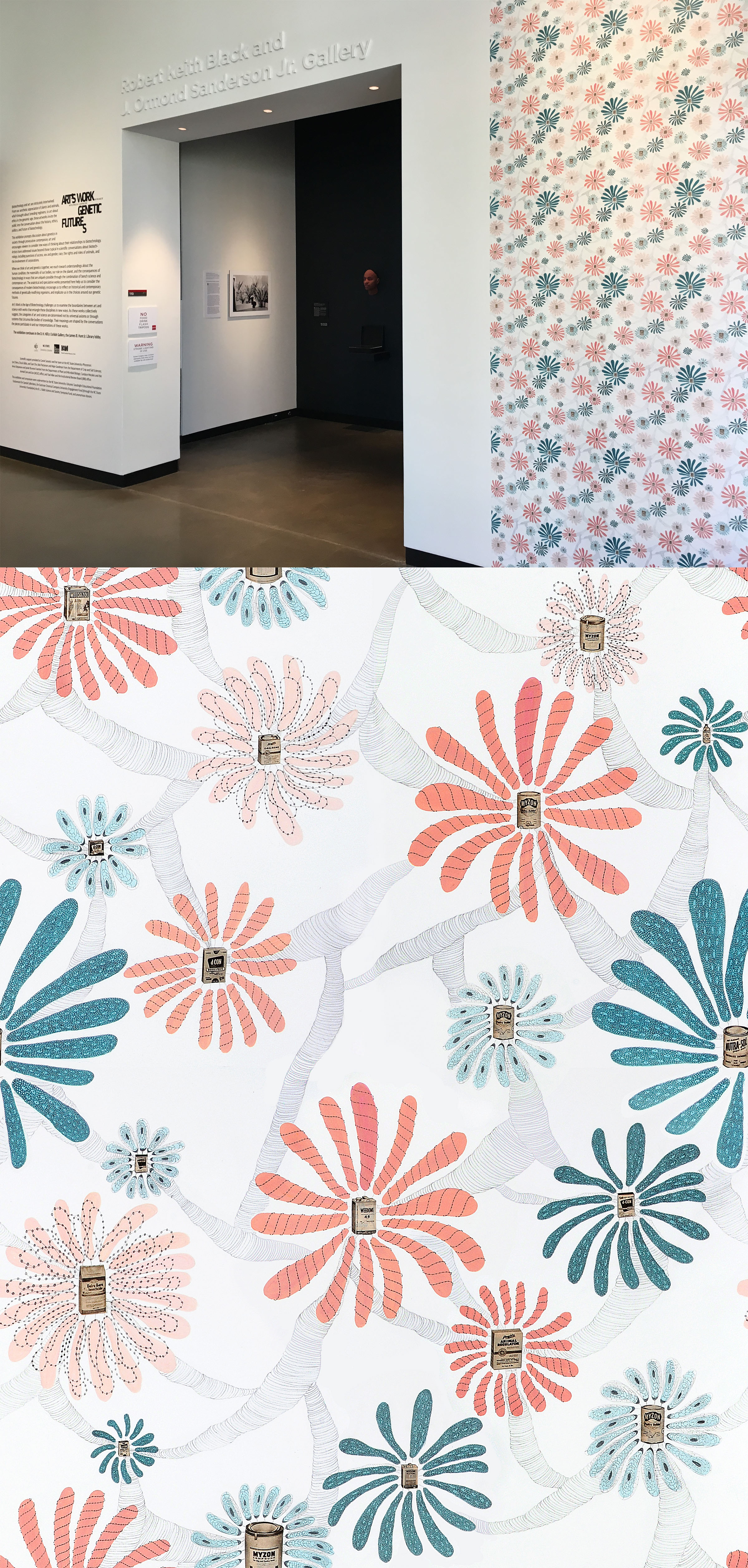
![Maria McKinney, Longevity/Apoptosome, Black Water Lad (HE2067) [image] and Myostatin [sculpture], from the series Sire (2016). Image by Molly Renda, courtesy of the Gregg Museum of Art & Design. Maria McKinney, Longevity/Apoptosome, Black Water Lad (HE2067) [image] and Myostatin [sculpture], from the series Sire (2016). Image by Molly Renda, courtesy of the Gregg Museum of Art & Design.](https://leonardo.info/sites/default/files/styles/bootstrap_extra_small/public/media_panes/rogers_fig9_mckinney.jpg?itok=-Cm0H9vS×tamp=1598055152)



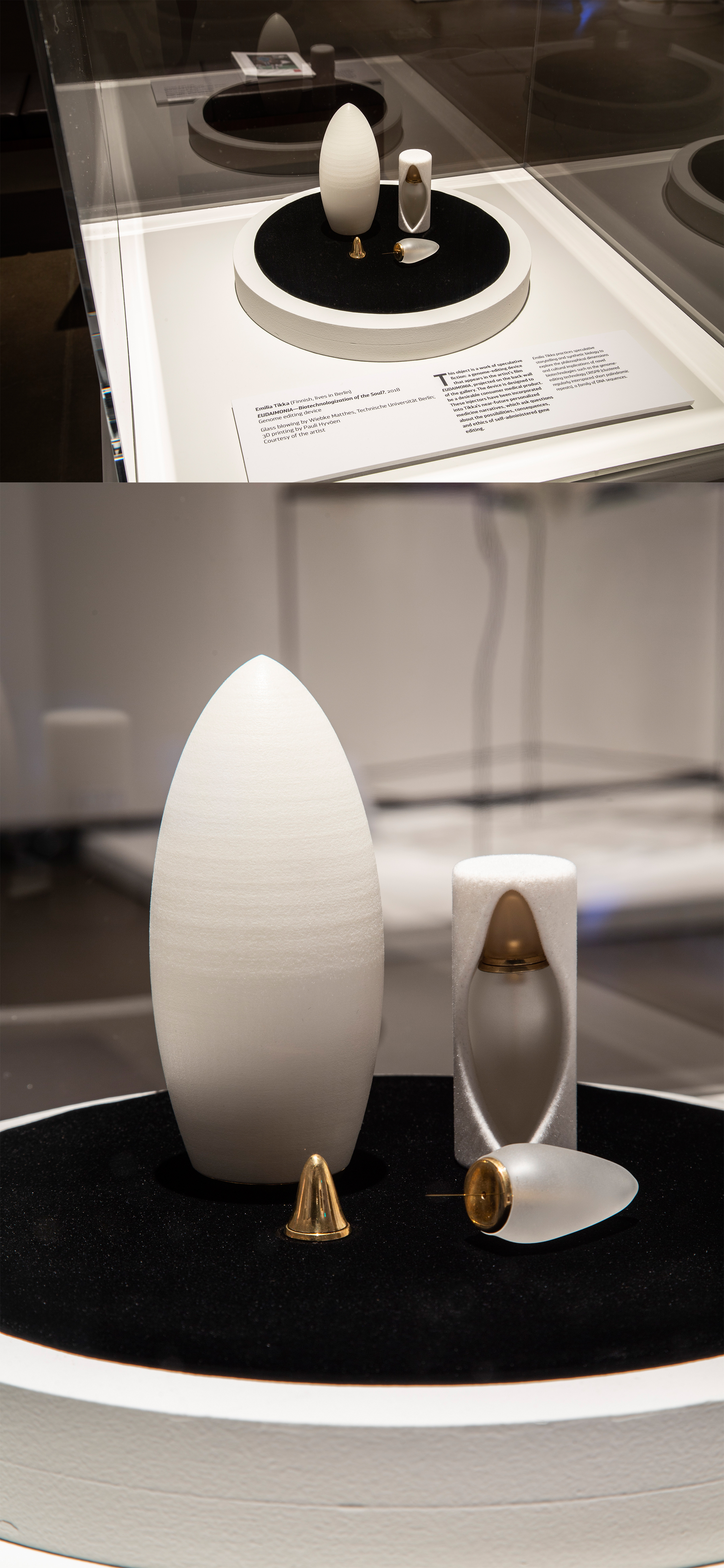


Curated by Hannah Star Rogers
Biotechnology and art are fascinatingly intertwined. From our aesthetic appreciation of plants and animals which brought about breeding regimes, to art about ethics in the genomic age, these artworks invite the public into the conversation about the history, ethics, politics, and future of biotechnology.
Art’s Work in the Age of Biotechnology: Shaping Our Genetic Futures is a multi-site exhibition that explores art’s relationship to biotechnology. The main exhibition was held at North Carolina State University October 2019–March 2020 and was sponsored by the Genetic Engineering and Society Center, the NC State University Libraries, and the Gregg Museum of Art & Design. The project included a Field Trial exhibition at CAM Raleigh, a related interdisciplinary planning symposium, and installations at the Gregg Museum of Art & Design, the D.H. Hill Jr. Library, the Hunt Library, and the NCMA Ann and Jim Goodnight Museum Park, as well as a response symposium. The exhibition aimed to elicit discussion about genetics in society through provocative contemporary art and to offer viewers new ways to think about their role in the genetic revolution. Artists addressed questions often set aside in scientific conversations about biotechnology including questions of access, sex and gender, race, the rights and roles of animals, and the involvement of corporations. READ MORE
Hannah Star Rogers
Curator, educator
Email: hsr2120@columbia.edu
Excerpted from a gallery on Leonardo Just Accepted
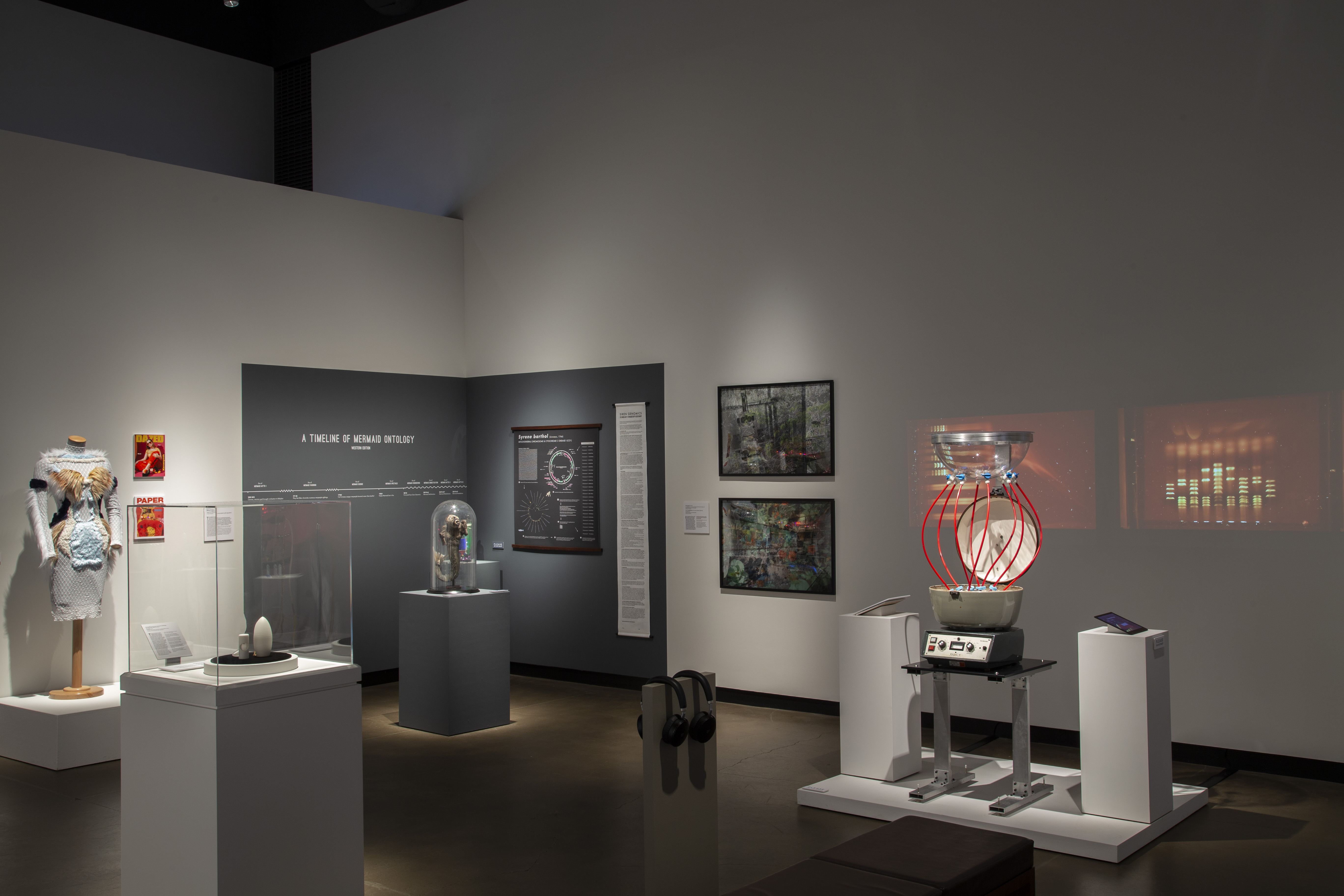
Art’s Work in the Age of Biotechnology at the Gregg Museum of Art & Design in Raleigh, NC. Installation image by Matthew Gay, courtesy of the Gregg Museum of Art & Design
Special thanks to the project team, including Molly Renda, Fred Gould, Todd Kuiken, Elizabeth Pitts, Patti Mulligan, Chris Vitello, Chris Tonelli, Sharon Stauffer, and Roger Manley. Further thanks to the staff of the Gregg Museum of Art & Design, the NC State University Libraries, particularly NC State University Libraries External Relations team, and the Genetic Engineering and Society Center.
Kerasynth (2018)
Diana Eusebio, Erin Kirchner, Grace Kwon, Rachel Rusk, and Sydney Sieh-Takata
This artwork technically and critically engages the idea of animal-free wool through kerasynth, a synthetically-grown biological material that can replace all keratin-based animal fibers. The team of students from the Maryland Institute College of Art (MICA) participated in the 2018 Biodesign Challenge team under the guidance of Ryan Hoover, creating this work of technical fact and future-oriented critical design fiction. The team has conducted experiments in using tissue engineering to grow wool hair follicle germ (HFG) cells on microfluidic devices designed to provide the cells with nutrients and to remove waste. The subsequent wool fibers could then be harvested and further processed or remain attached to the device. In addition to the technical aspects of kerasynth, the artists paid special attention to the use of animals and issues of waste in this project. The artists note that by using animal-derived growth medium, their project cannot be vegan, and no such alternative exists at this time. Kerasynth’s creators also considered the social and political dimensions of the future they imagined—not as a world of perfect technologies and better people, but a world of new technologies with people very much like those we know today. The project uses the tradition of critical design to propose a future for this fiber through information about the artists’ actual research and initial development project, presented through graphics and film, along with garments made of today’s materials that help viewers imagine what kerasynth fibers might be able to do in the future. This hybrid artwork is both speculative and technical, demonstrating the potential of microfluidic casting and creative uses for the fiber in futuristic garments, while raising questions about the limitations of tissue culture, which still requires bovine calf serum to keep the growing cells alive.
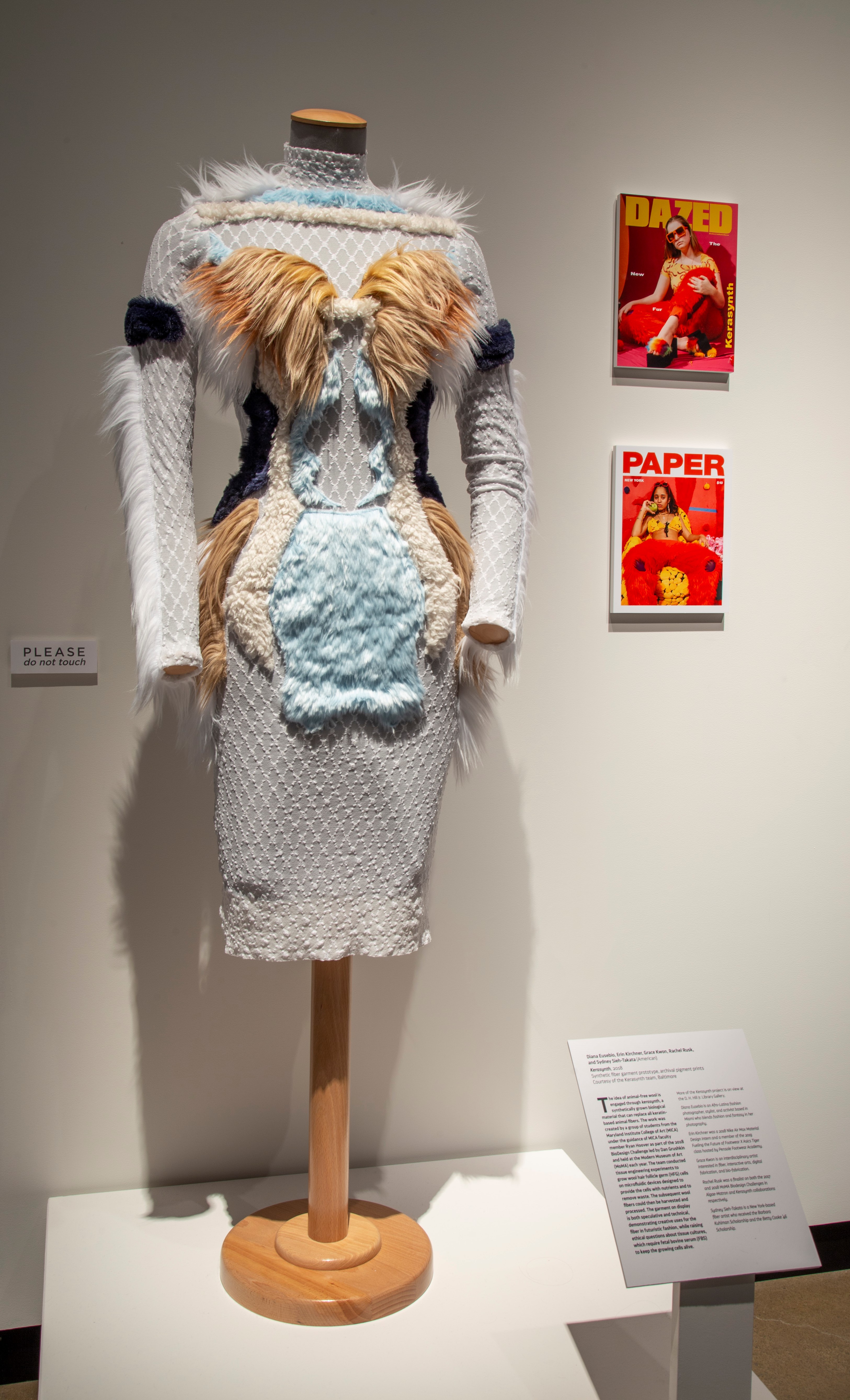
Diana Eusebio, Erin Kirchner, Grace Kwon, Rachel Rusk, and Sydney Sieh-Takata: Kerasynth (2018). Image by Molly Renda, courtesy of the Gregg Museum of Art & Design.
Laboratory Life (for Oryx and Crake) (2006–2007)
Suzanne Anker
In the series Laboratory Life (for Oryx and Crake), Anker investigates the visual, geographic, and spatial world of the scientist. Her layered images, with their palette of places, repeated colors, and familiar yet non-domestic forms, implicitly ask what the material cultural context of science does to the life of the scientist and the potential knowledge being created. Anker’s evocative title references two books: one from the social sciences and the other from literature. The first is Laboratory Life: The Construction of Scientific Facts (Latour and Woolgar 1979), which offers a sociological account of how scientific knowledge is created. It follows scientists through routine lab practices, the publication of papers, scientific prestige, research finances, and other elements of laboratory life. The second book that Anker’s work references is Oryx and Crake, Margaret Atwood’s 2003 novel of the same name, which the author refers to as “speculative fiction.” The novel follows a post-apocalyptic character called Snowman. Among the twists pertinent to Anker’s artwork, another character named Crake attends the highly respected Watson-Crick Institute for advanced bioengineering, while Jimmy (“Snowman”) studies the humanities at the Martha Graham Academy, but the education is only seen as useful for its propaganda applications. Anker’s images show us the world of scientists at renowned institutions but avoid the documentary style of Latour and Woolgar’s foundational science studies text by complicating it through the filter of point of view and consequences as depicted in Atwood’s novel. The scientists who populate this laboratory bring with them perspectives that Anker’s images continuously invoke.
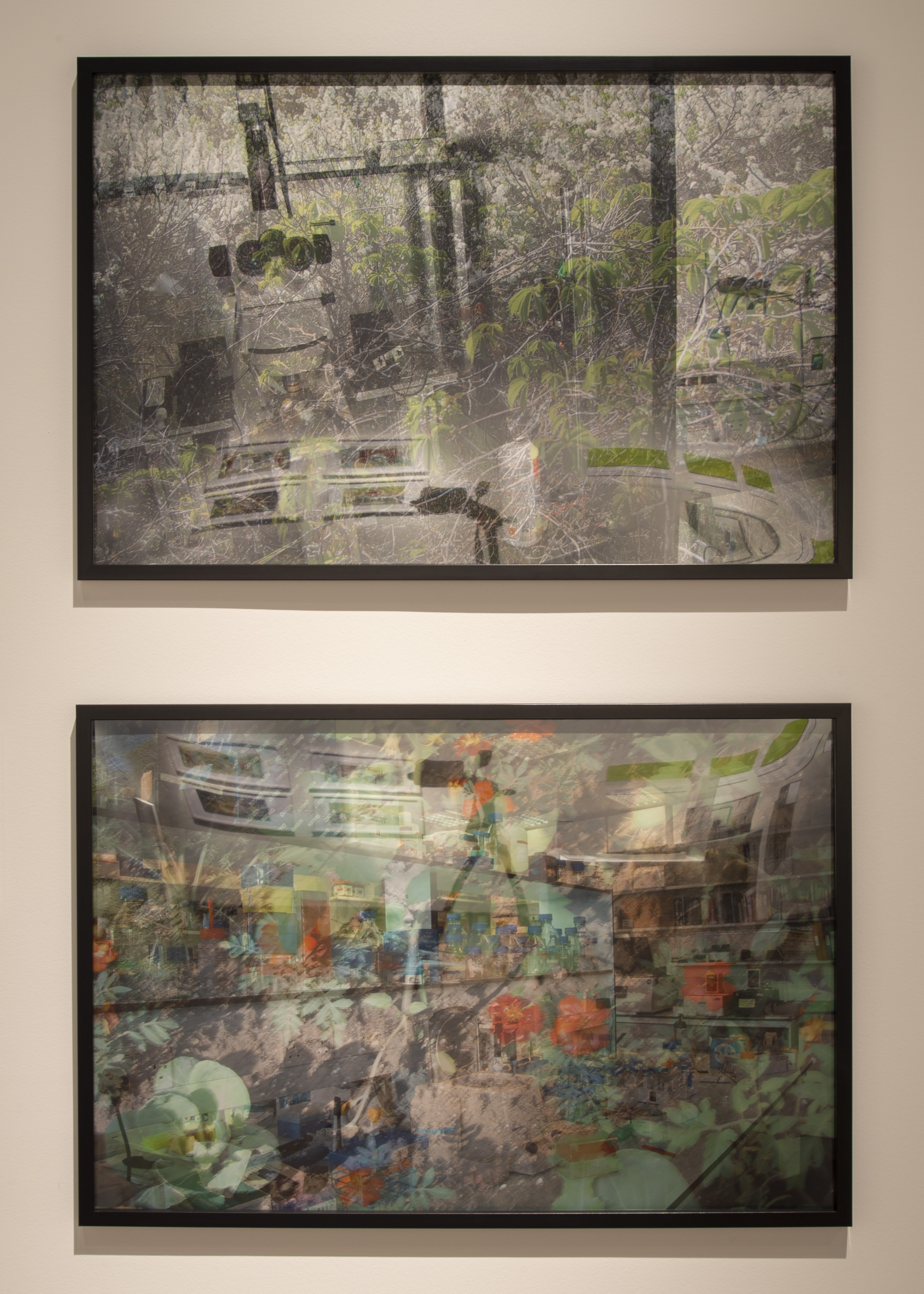
Suzanne Anker’s series Laboratory Life (for Oryx and Crake): Vanishing Point (2006), Snowman (2007). 24 x 36 digital prints, Image by Matthew Gay, courtesy of the Gregg Museum of Art & Design
Lucky Mice (2019)
Joe Davis, Dana Dal Bo, and Ashley Seifert
Lucky Mice explores the possibility that luck is heritable—a notion with ties to folktales and science fiction—by offering a mouse rolling dice and tabulating the results for comparison. Joe Davis explains that, while serendipity might be ascribed to chance, closer examination suggests it is chance coupled with coincidence. Serendipitous discovery comprises both the ability to accommodate unexpected events and a kind of judgment in recognition. History recounts many accidents that, through reasoning and deduction, become transformed into opportunity. Investigations of luck have been undertaken in psychology, cognitive science, information science, and economics, but correlations of serendipity and genetics have never been studied. Production of enhanced traits in Homo sapiens would take centuries, but a single generation of mice can be produced in only about twelve weeks. The installation includes a film of the first steps of this research performed at NC State University in which a single mouse uses a specially designed archimedes screw which throws dice. Lucky Mice experiment is documented and presented as an installation, complete with the efforts to secure permission from the Institutional Animal Care and Use Committee at the University of Kentucky to use mice as part of the Lucky Mice experiment. This artwork attempts to participate in a scientifically rigorous approach by using protocols for ethical research and humane treatment of laboratory animals. The use of live mice highlights human-animal relationships and examines regulations underlying the use and care of animals.
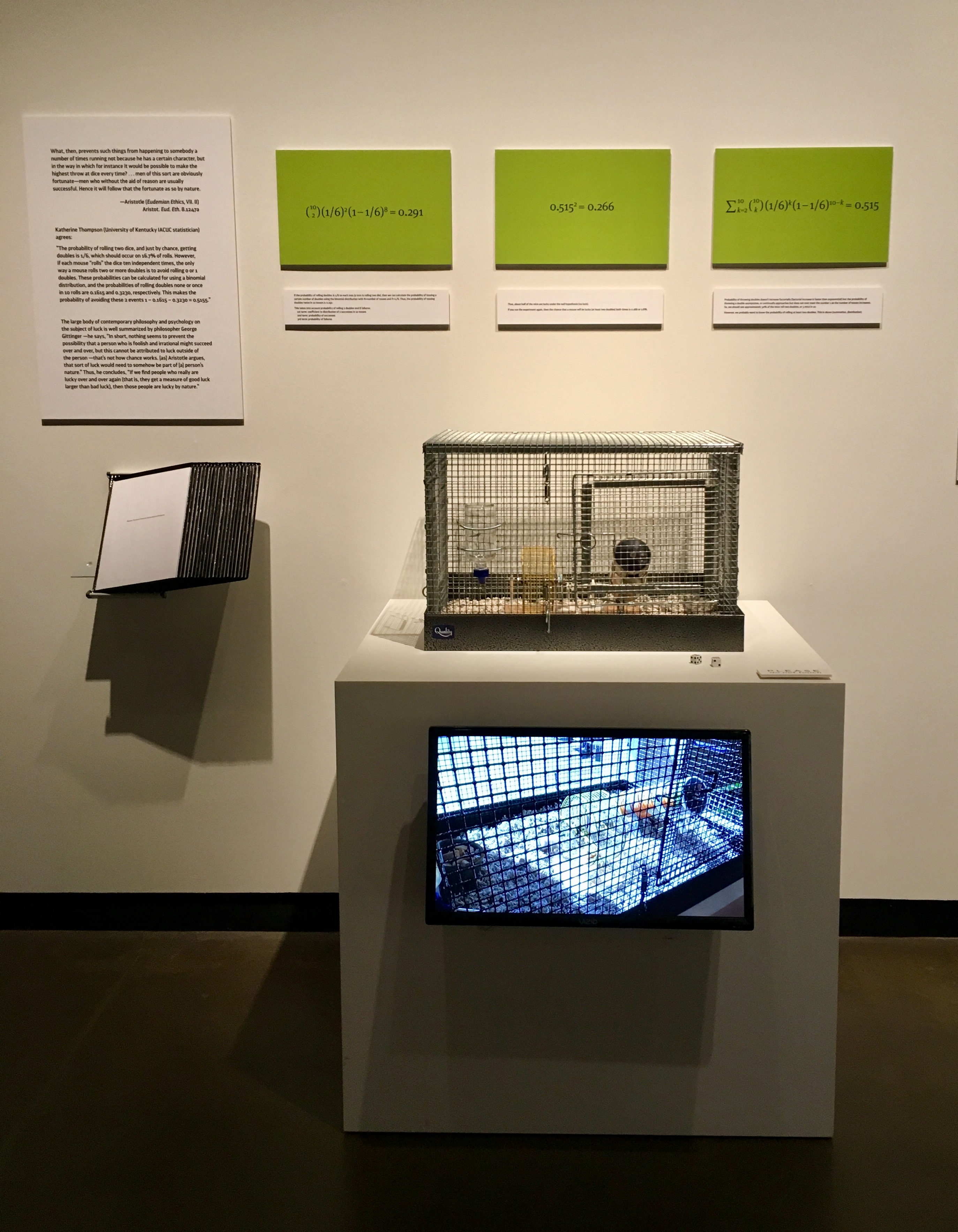
Joe Davis, Dana Dal Bo, and Ashley Seifert, Lucky Mice (2019). Image by Molly Renda, courtesy of the Gregg Museum of Art & Design.
Stranger Visions (2012–2014)
Heather Dewey-Hagborg
Heather Dewey-Hagborg created portrait sculptures from analyses of genetic material collected in public places and her resulting artwork Stranger Visions has been influential in bioart and DIY communities. Stranger Visions received international press on CNN, and in the Wall Street Journal, the Times (UK), and the Daily Mail (UK), and won the Ars Electronica honorary mention in 2015. Working with the traces that strangers unwittingly leave behind, Dewey-Hagborg calls attention to the developing technology of forensic DNA phenotyping, the impulse toward genetic determinism, and the potential for a culture of genetic surveillance. To create the sculptures, Dewey-Hagborg collected hair, chewing gum, and cigarette butts from the streets, public bathrooms, and waiting rooms of New York City. She extracted and analyzed each sample’s DNA to computationally generate 3D-printed, life-size, full-color portraits representing what those individuals might look like, based on genomic research. More recently, in her new work Probably Chelsea (2017), Dewey-Hagborg created thirty different possible portraits of Chelsea Manning algorithmically generated by an analysis of Manning’s DNA. The artist writes that this shows that an individual’s DNA can be interpreted as data and demonstrates how much interpretation is involved in attempts to translate DNA into specific characteristics.
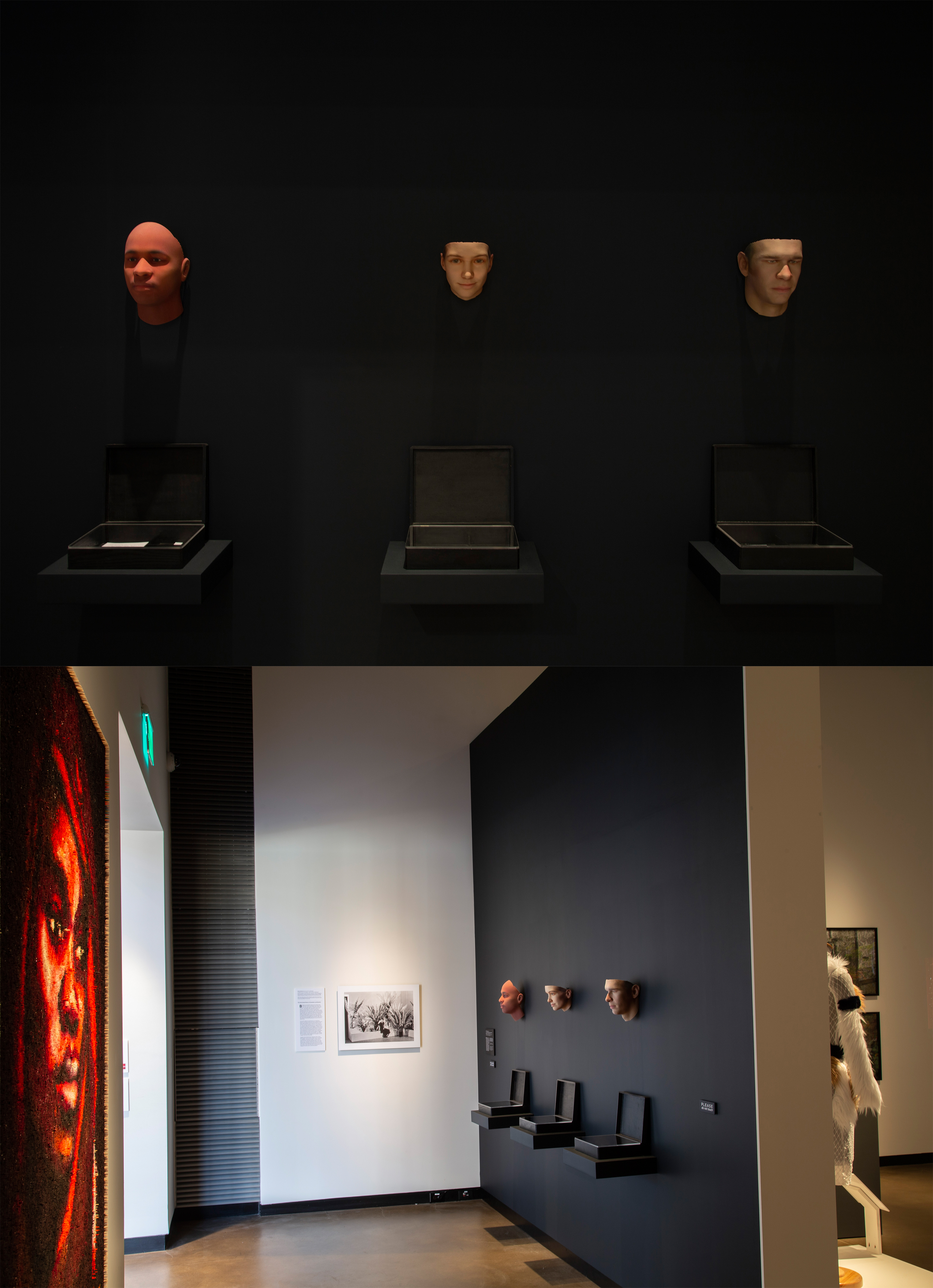
Heather Dewey-Hagborg, Stranger Visions (2012–2014). Image by Matthew Gay, courtesy of the Gregg Museum of Art & Design.
Novel Ecosystem Generator (2019)
Aaron Ellison and David Buckley Borden
David Buckley Borden and Aaron Ellison are a Cambridge-based creative team that unites art, design, and environmental science in place-based projects [1, 2]. Their research-driven creations communicate abstract, often technical ecological concepts. They engage with local communities to learn about their lives, practices, cultures, and customs, and create visual art that often uses vernacular tropes to envision our changing world. Their installations provide spaces for thoughtful consideration and provocative discussions about how humans are altering the environment and the opportunities available to collectively rethink all our actions, for better or worse.
People are constantly disassembling, rearranging, and restructuring genes, organisms, ecosystems, and the environment. This process of creating novel ecosystems occurs both deliberately and unintentionally, creating consequences that range from the predictable to the unimaginable. Deliberate cross-breeding, production of genetically modified organisms (GMOs), introduction of “gene-drives” for mosquito control, or gene splicing using CRISPR all result in the introduction of new kinds of plants and animals. Similarly, people transport species from state to state and between countries, leading to the arrival and spread of introduced species in new places. These movements of species and their interaction with native organisms, coupled with ongoing, human-caused changes to the land, sea, and climate, together lead to unexpected and unintended consequences.
The Novel Ecosystem Generator represents a process engine that takes in existing genes, organisms, or entire ecosystems, restructures and rearranges them, and outputs new biological systems. Built from native, locally-milled timbers and recycled blower-fans used in an experiment that heated up forest plots to simulate and study global warming, the sculpture physically enacts the idea that new ecosystems are generated by inputs through a machine: it points out that whether or not we intend to create new ecosystems, there are a set of processes that shape them. The before and after conditions on either side of the broken DNA ladder represented by the rails and cross-ties challenge viewers to consider profound examples of this Anthropocene phenomenon.
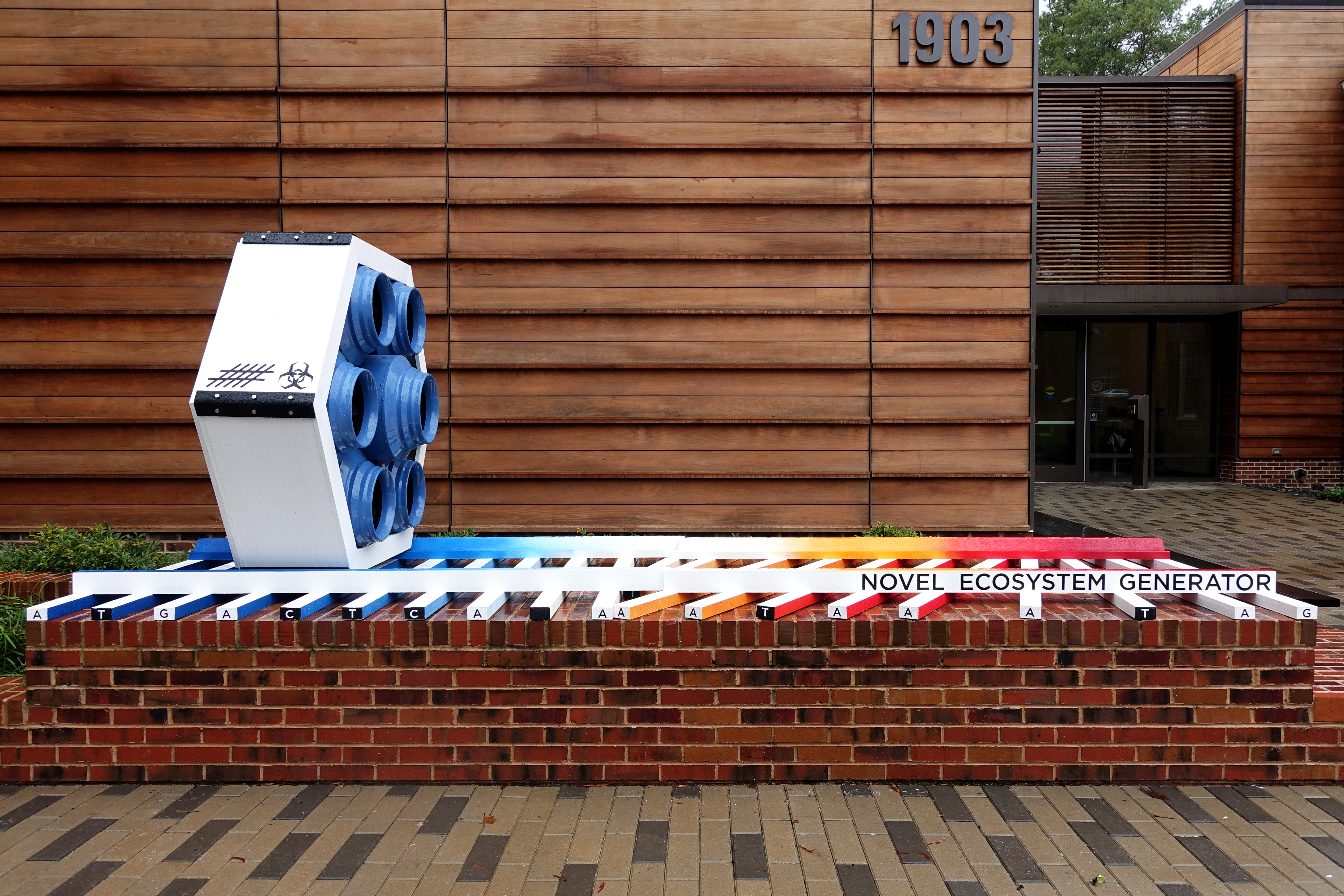
Aaron Ellison and David Buckley Borden, Novel Ecosystem Generator (2019). Image by David Buckley Borden, courtesy of the artist.
Fragments (2015)
Emeka Ikebude
In Fragments, the artist creates an imposing portrait made from discarded toothpicks, each of which potentially contains the DNA of its individual user. The image of the woman created by the toothpicks is described by the artist as a “a revolutionary black woman....This woman comes with her own light/fire to interrogate the epistemologies that frame her condition and burn things down if necessary.” The toothpicks were mainly collected in restaurants in Texas where they had been discarded. The artist dyed them in bunches with organic dyes that are harmless to the environment and painstakingly arranged these bundles into a single large image. The piece plays on conventions of found and community art since the piece is produced by an organizing artist but would not have been possible without the collecting of these found toothpicks from many individuals who unwittingly contributed them. While the identities of these toothpick users will never be known, the collective image their discarded toothpicks create raises questions about their biological information, which potentially includes a tiny amount of blood, tissue, and digestive microbes, all of which we each so easily discard. The anonymity of the toothpick users settles into the universality of our bodies—distinguishing details yet erasing differences. The artwork inquires about our understanding of the complex relationship with our microbial community, which would help inform a better understanding of the human body, foster healthier habits, and improve well-being. Each toothpick in this composition represents a human being—a contributor and participant in this project of rethinking the bacterial and viral genomes of the human body.
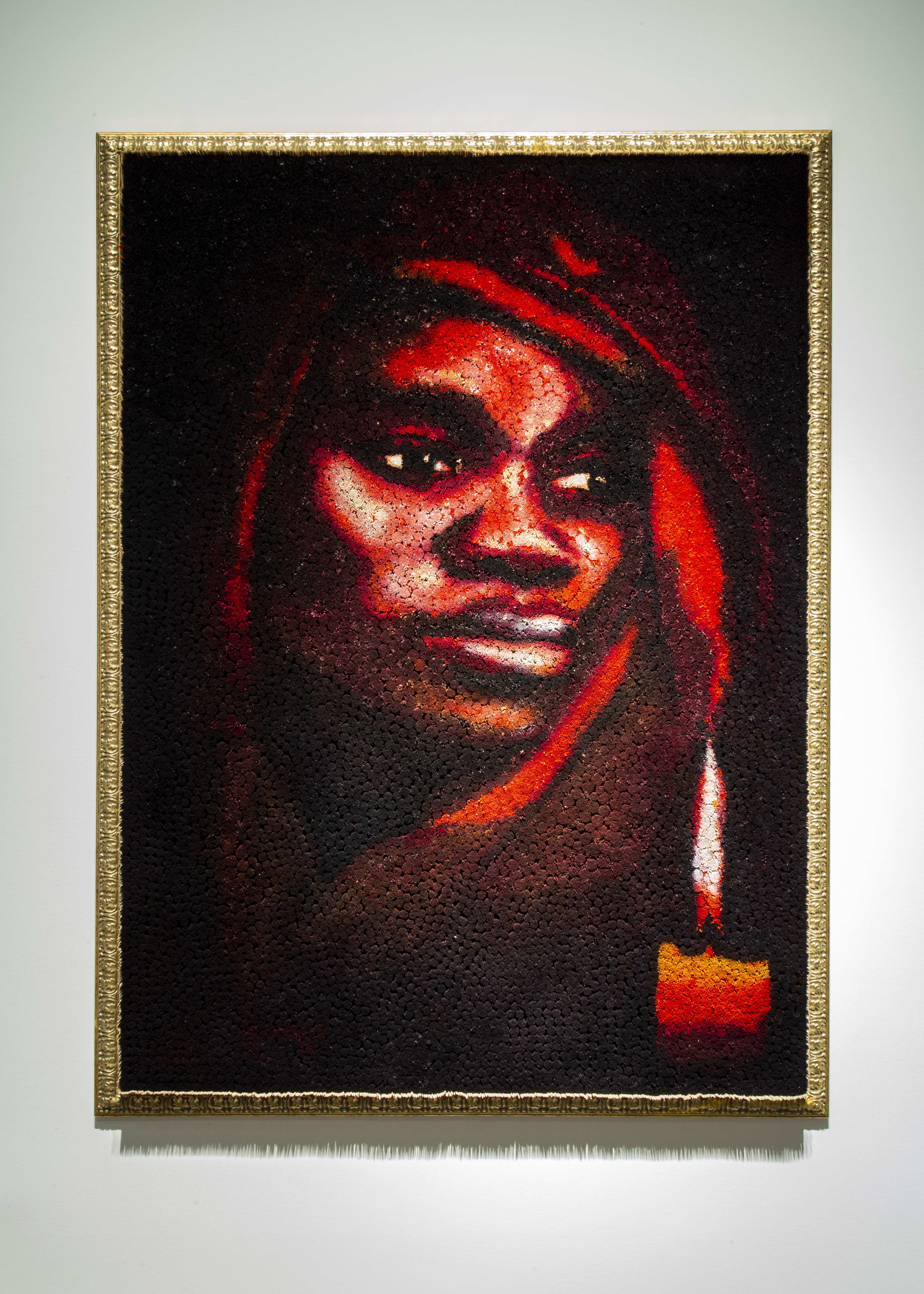
Emeka Ikebude, Fragments (2015). Image by Matthew Gay, courtesy of the Gregg Museum of Art & Design.
In Posse: Making Female Sperm (2018–ongoing)
Charlotte Jarvis
What would it mean if we could create female sperm? Could changes in reproductive biotechnologies affect interpretations of gender? Artist Charlotte Jarvis is collaborating with scientist Susana Chuva de Sousa Lopes and Kapelica Gallery/Kersnikova Institute to make semen from her (“female”) stem cells. To do this they are using induced pluripotant stem cells derived from Jarvis’s blood, altering their chromosomes, and differentiating them into the sperm-producing cells found in male testicles. The project is presented as part of a contemporary reenactment of the ancient Greek festival of Thesmophoria—a women-only fertility ceremony in honor of the goddesses Demeter and Persephone. The artist has used the possibility of creating female sperm from her own cells as a starting point for reimagining Thesmophoria—for populating a history without patriarchy and a future in which the gender/genital power balance is redressed. In Jarvis’ installation, viewers find an early phase of her work derived from collecting blood samples from groups of women, mounted on an altar surrounded by evidence of the rituals of the Thesmophoria festival. She invites us to pay homage to the mixture of science and art that informs our own beliefs and influences our biotechnological futures. The piece provokes conversations about the way that biotechnology constructs, augments, and complicates sex and gender.
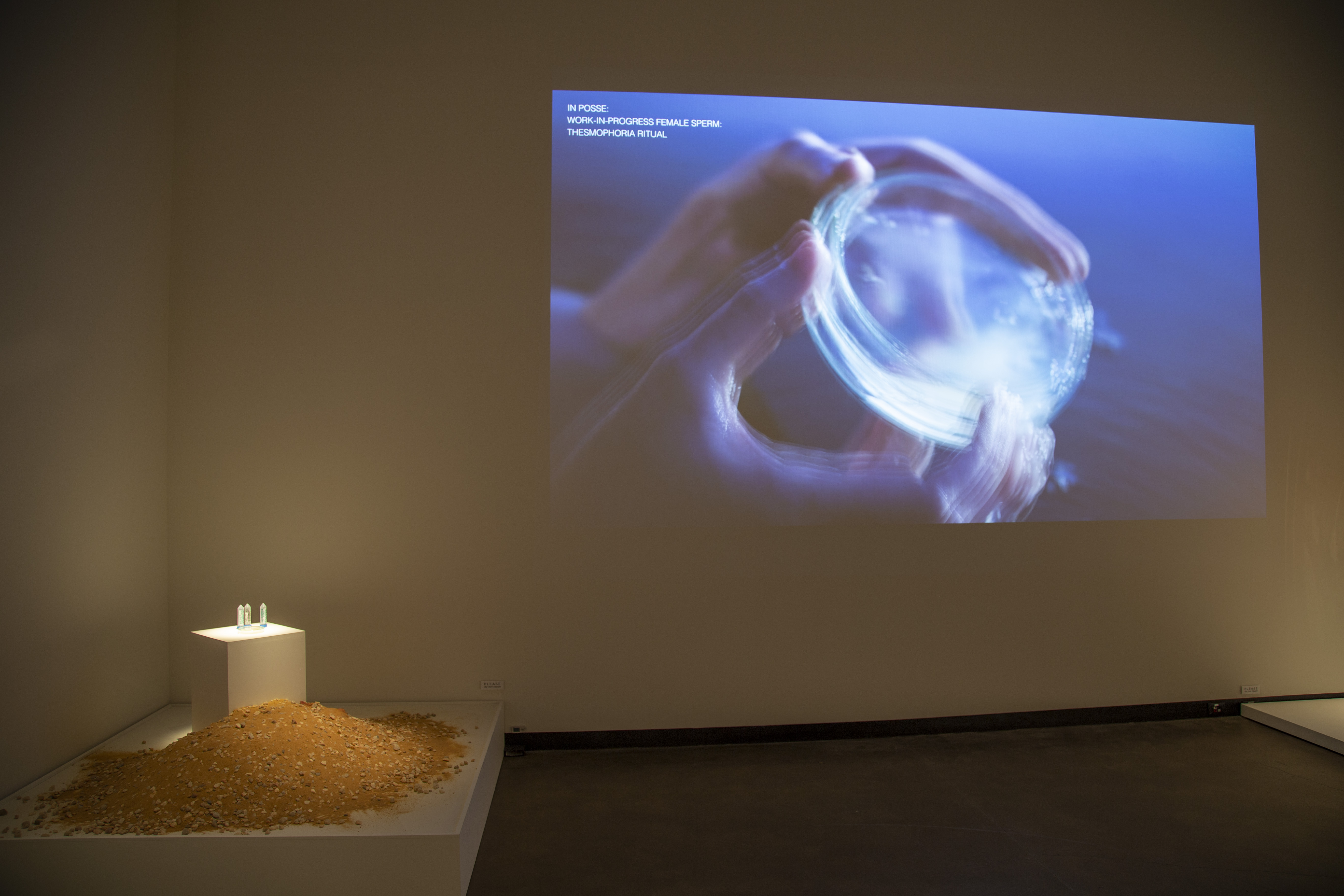
Charlotte Jarvis: In Posse: Making Female Sperm (2018–ongoing). Image by Matthew Gay, courtesy of the Gregg Museum of Art & Design.
Longevity/Apoptosome, Black Water Lad (HE2067) and Reproduction/Chromasome, Templemichael Zebo (FR2279), from the series Sire (2016)
Maria McKinney
These photographs show cattle wearing specially designed sculptures made of semen straws, a device used since the 1960s to collect and store bovine sperm for artificial insemination. In these portraits, informed by pagan rituals and contemporary biotechnology, Ireland-based artist McKinney reflects on our relationships with animals through agriculture over time. In pre-Christian Europe, where people annually performed customs in relation to the reaping and sowing of the harvest, part of this practice involved making a corn dolly—a symbol meant to enable fertility through the intricate handcraft of binding straw with the final sheaf of that year’s crop. This practice was the basis for the semen straw weaving that makes up McKinney’s sculptures. In contemporary society, genomics has given humans the ability to scientifically influence how nature behaves in future generations of animal and plant species. The emergence of bioinformatics has allowed scientists to direct breeding strategies with the objective of achieving more physically healthy and commercially productive animals. Through McKinney’s sculptures, she visualizes the intangible genetic interventions and genetic structures now coded into the bodies of these animals.
Reproduction/Chromosome, Templemichael Zebo (FR2279) makes reference to the X chromosome, one of the two sex-determining chromosomes in mammals (X for female and Y for male). In Longevity/Apoptosome, Black Water Lad (HE2067), the structure of the sculpture is based on an apoptosome—a large protein molecule involved in programmed cell death within an organism in response to internal or external stimuli. To create Longevity/Apoptosome, Black Water Lad (HE2067) and Reproduction/Chromasome, Templemichael Zebo (FR2279), McKinney collaborated with Dovea Genetics, a farm with ninety bulls standing at stud producing semen in a controlled environment. Her scientific collaborators were quantitative geneticist Donagh Berry (The Agriculture and Food Development Authority of the Republic of Ireland), and genome biologist David MacHugh and Head of Veterinary Clinical Studies Michael Doherty (both University College Dublin). The work was realized in consultation with a veterinarian through close work with the animals’ handlers to ensure they were not distressed while making the work.
![Maria McKinney, Longevity/Apoptosome, Black Water Lad (HE2067) [image] and Myostatin [sculpture], from the series Sire (2016). Image by Molly Renda, courtesy of the Gregg Museum of Art & Design. Maria McKinney, Longevity/Apoptosome, Black Water Lad (HE2067) [image] and Myostatin [sculpture], from the series Sire (2016). Image by Molly Renda, courtesy of the Gregg Museum of Art & Design.](https://leonardo.info/sites/default/files/media_panes/rogers_fig9_mckinney.jpg)
Maria McKinney, Longevity/Apoptosome, Black Water Lad (HE2067) [image] and Myostatin [sculpture], from the series Sire (2016). Image by Molly Renda, courtesy of the Gregg Museum of Art & Design.
Terra Et Venti (2018)
Joel Ong
Joel Ong’s Terra Et Venti (“between the wind and the ground”) is a speculative research project that explores the role that synthetic biology may play in planetary-scale geoengineering and weather modification practices in the future. This artwork builds on the tradition of treating the genetic sequences as a medium for artistic expression through a multi-modal installation. Pseudomonas syringae, a plant pathogen, is involved in atmospheric biological ice nucleation and the formation of clouds. The bacteria, which are ubiquitous in the soil, on plants, and in the air, travel freely on planetary circulation systems and are literally rainmakers. The bacteria expresses a protein on its surface that encourages an orderly arrangement of water molecules. That in turn acts as a nucleation site, stimulating the formation of ice at temperatures far higher than those normally required. Scientists have studied microorganisms found in precipitation since the 1960s. Research presented to the American Society for Microbiology suggested that the bacteria may have evolved to use the water cycle to facilitate their own dispersal (1). These bacteria have even been found in hailstones, suggesting further association with the earth’s hydrological cycle. P. syringae also has commercial applications as part of the mixture added to snow machines.In Terra Et Venti, the ice-nucleation activity of the bacteria is simulated with parametric speakers tracing lines across the space as a digital version of a cloud is created in real time. The computational system presented in the gallery generates text for insertion into the genome of a specific bacteria. In addition, along with Natalie Plociennik, Ong created artistic renderings of the biological processes of the P. syringae. Ong’s research was supported through a residency in microbiology at the interstitial ecologies of soil and wind at the Coalesce Centre for Biological Art.
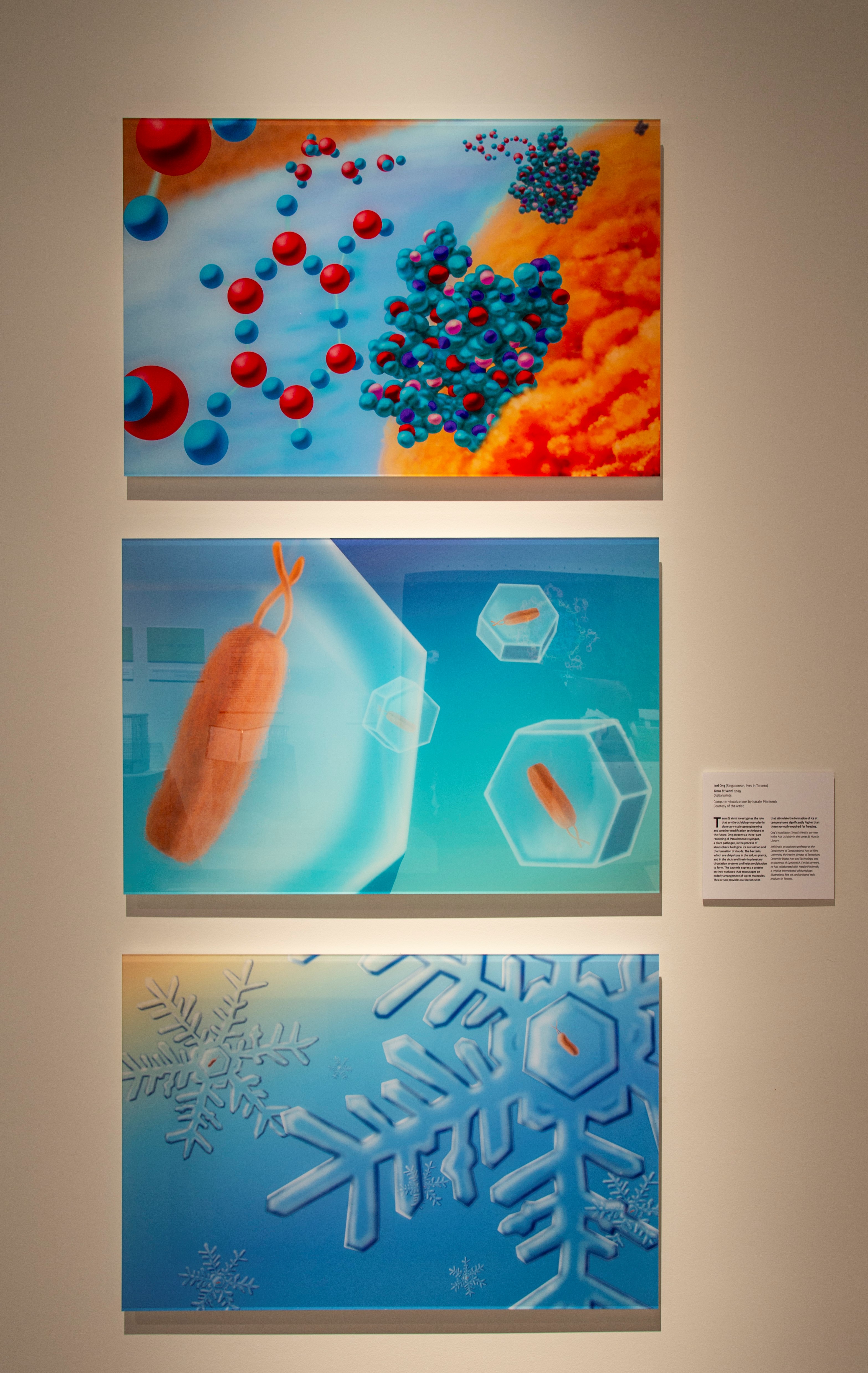
Joel Ong, Terra Et Venti (2018). Image by Molly Renda, courtesy of the Gregg Museum of Art & Design.
We Make Our Own Luck Here (2018–ongoing)
Ciara Redmond
What if every clover had four leaves? We Make Our Own Luck Here investigates the relationship between biotechnology and culture using four-leaf clovers, a symbol for good luck. Using traditional selective breeding methods (mating two plants with desirable traits and harvesting the seeds), the artist created white clover (Trifolium repens) plants with high numbers of four-leaf clovers. The four-leaf clover is a variety of the three-leaf clover. Usually, around one in 5,000 clovers has this mutation. It is not known if the factors leading to four leaves in clovers are environmental, genetic, or a combination of these and other factors. The four-leaf clover has become associated with good luck because its natural occurrence is rare. The earliest mention of “Fower-leafed” grass occurs in the dramatically named 1640 text Theatrum Botanicum (2) and their continuing cultural importance is born out in their symbolic use by today’s SpaceX company, which uses a four-leaf clover emblem on embroidered patches associated with each launch. By exploring and modifying the genetics of a plant to create a “lucky” specimen, Redmond proposes that we play with the ideas of fate and destiny, whether they be genetic or supernatural. Are lucky four-leaf clovers still lucky if we use science to make them common? Scientists use biotechnology to transform our societies but we can quickly take these innovations for granted. Can biotechnology bring us joy? Or should we be critical of how humanity might frivolously use its power? Could there ever be a genetic alteration conducted by humans that is not a cultural product?
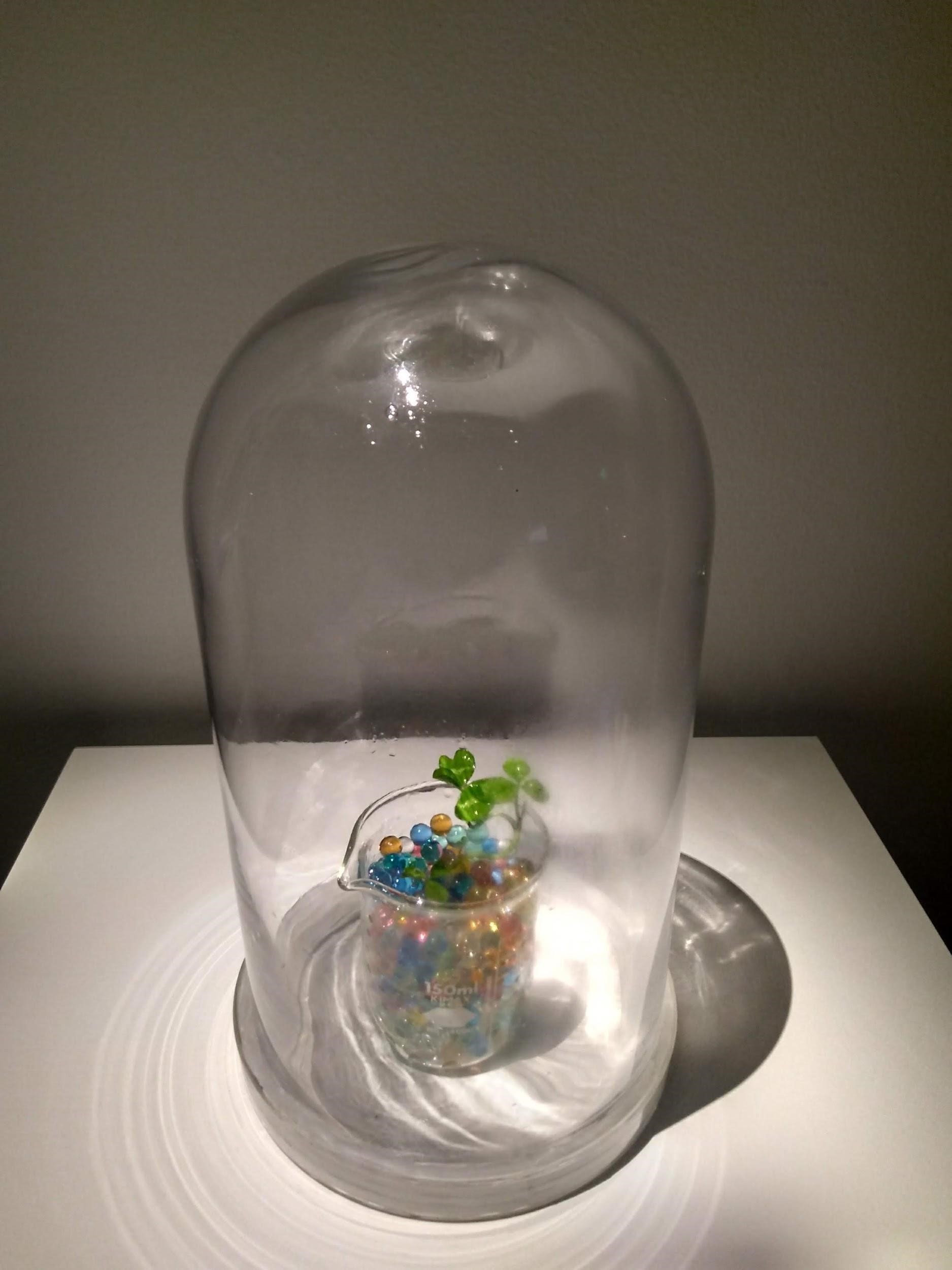
Ciara Redmond, We Make Our Own Luck Here (2018–ongoing). Image by Hannah Star Rogers, courtesy of the Gregg Museum of Art & Design.
back to top
The Mermaid De-Extinction Project (2019)
Richard Pell
Stories of intelligent human-fish hybrids that occupy the far reaches of the seas have existed for eons in our collective mythological mind. Whether land-locked desert or frozen arctic, their presence is recorded in cave paintings and epic tales. They often sing to sailors, encouraging them to venture further out in stormy weather. Through the male sailors’ gaze, mermaids provide seductive reasons to explore the outer edge of the map, as well as a cautionary tale for those who might be so inclined. It often ends badly for them. In science there is a similar tension between the driving force of the pursuit of knowledge, and the dangers of falling in love with one’s own hypothesis. Despite the best attempts at creating a rational process for generating repeatable and falsifiable results, scientific curiosity is often propelled and humbled by grand and fallible human desires. The “Mermaid De-Extinction Project” attempts to further the cultural evolution of mermaid sightings through the investigation of a cache of anonymously submitted files purporting to contain the genetic sequence of a mermaid of the species Sirene barthol. Preliminary analysis of the mitochondrial DNA indicates a highly unusual ancestry, implicating both the Pongo (orangutan) and Salmo (salmon) genuses. While such a phylogeny is unheard of within the animal kingdom, it does strangely correlate with the chimerica provenance of 19th century “feejee mermaid” specimens, such as the one famously exhibited at PT Barnum’s American Museum. These specimens travelled widely during the 19th century and presented a compelling paradox for naturalists who were still struggling to account for the unprecedented duck-billed platypus. Both specimens inspired widespread debate concerning their authenticity, resulting in one platypus specimen having its bill torn off in an effort to prove it a hoax. Subsequent investigations revealed the Feejee Mermaids to be well-executed taxidermy mashups involving the stitching together of a juvenile orangutan torso, onto the lower half of an adult salmon. Surviving examples of Feejee Mermaid specimens may be viewed today in the prestigious natural history collections of Harvard’s Peabody Museum in the US, and the British Museum in the UK.

Richard Pell, The Mermaid De-Extinction Project (2019). Image by Matthew Gay, courtesy of the Gregg Museum of Art & Design.
Chemical Bouquet II (2012) and Miracle Grow (2012)
Kirsten Stolle
In Chemical Bouquet II, Stolle examines the overuse of pesticides and the introduction of GMOs through the lens of ornately framed, nineteenth-century floral still life paintings. Stolle’s Victorian flower bouquets overflow with familiar botanical plants that have been subverted and populated with odd and unsettling imagery associated with chemically intensive farming practices. In Stolle’s still life collages, beautiful flowers have been replaced with bloated cow udders, syringes, medicinal and botanical plants from the eighteenth through the twentieth centuries (corn, soy, rapeseed, cotton), Agent Orange barrels, and aspirin pills and bottles—all components associated with Monsanto Company products. The artist collected collage material from vintage botanical lithographs, pharmaceutical catalogs, and agricultural (USDA) manuals. In Miracle Grow, Stolle replicates her technique for drawing viewers into the details of the artwork through the convention of wallpaper graphics. Rather than presenting her critique through the conventions of the still life, here she makes use of the parameters of an ordinary-looking wallpaper. The suggestion of the wallpaper is that the effects of agro-businesses are always present in our everyday lives, even if we are not taking direct notice of them.

Kirsten Stolle, Miracle Grow (2012). Image by Matthew Gay, courtesy of the Gregg Museum of Art & Design.
EUDAIMONIA (2018)
Emilia Tikka
What would a biotechnologization of the soul mean? Emilia Tikka’s EUDAIMONIA is a philosophical-speculative future scenario in which the human psyche and character has become a matter of molecular biology and can be altered with a personalized genome-editing device. In the imagined future of this artwork, scientists claim to have found that specific genes fundamentally determine human behavior. Explicit features of character, and psychological qualities such as empathy and creativity, are traced to even a single allele of a gene. These claims open up the question of whether the “optimization” of the human psyche would become an issue of genome editing and biotechnology. Tikka’s work raises questions about possible impacts of the novel genome-editing technology CRISPR through a critical, near-future scenario. The artwork is realized as a fictional genome-editing device. This injector-object is designed as a desirable consumer product. The model object is paired with a short film that makes use of the technology through narratives about people who might use this future product. The film suggests the possible societal impacts of the technology. The narrative unfolds in segments that create a dark poetic story of three individuals seeking help from a mysterious technology in their quest to find happiness in the contemporary Western capitalistic world. The near-future scenario thematizes the phantasmatic drive towards happiness as the ultimate goal of human existence.

Emilia Tikka, EUDAIMONIA (2018). Image by Molly Renda, courtesy of the Gregg Museum of Art & Design.
America Project (2016)
Paul Vanouse with Solon Morse, scientific collaborator
America Project is a biological art installation centered around DNA gel electrophoresis, also known as DNA fingerprinting, a process Vanouse has appropriated to produce recognizable images. The piece builds on his early work Latent Figure Protocol, which drew attention to the differences between the metaphorical fingerprint and the image produced by gel electrophoresis. In that work, lengths of DNA were cut using known enzymes and arrayed to create a specific image. Vanouse worked to draw attention to the details of the technology—and particularly to the lack of standardization in the use of enzymes—given the widespread use of DNA fingerprinting in court cases. America Project consists of a spittoon, where during a performance with the work, participants may offer a DNA sample by swishing saline in their mouths. This sample is then run as a single-gel electrophoresis tray. Vanouse has created specialized software that inverts the typical process, so that the artist can cut the DNA in specific locations to create a pattern. The fact that it is possible to use the mixture of DNA in the spittoon to create a predetermined image (for example, a flag or a crown) demonstrates that humans have much more shared DNA than differentiating sequences. The work emphasizes that we all share more than 99 percent of our DNA and subverts a biotechnology usually employed to differentiate between individuals to show how we are collectively much more biologically similar than different. The artwork was the winner of Distinction in the Hybrid Art category of the 2017 Prix Ars Electronica, the premiere cyberarts festival and competition in the world.
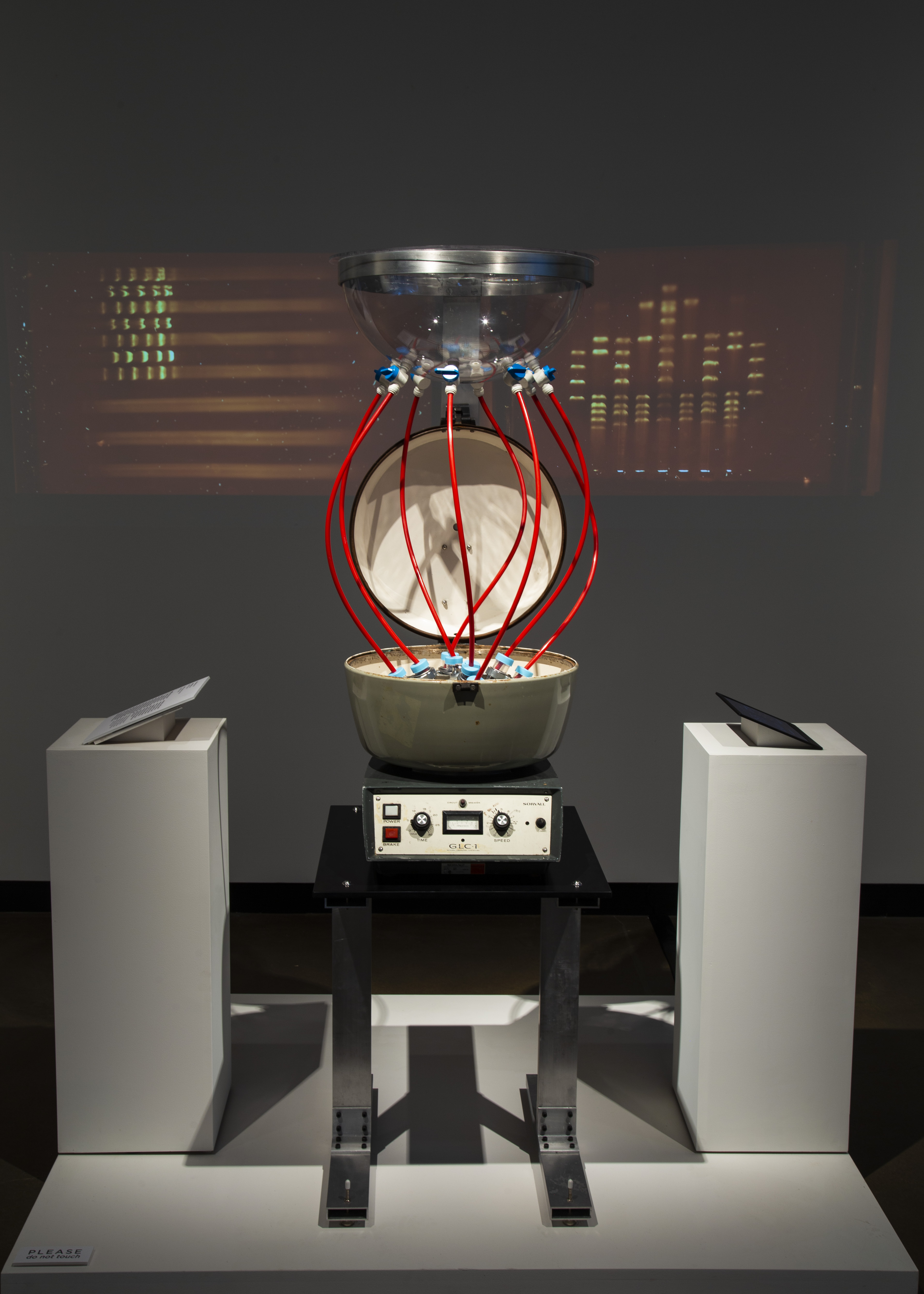
Paul Vanouse with Solon Morse, scientific collaborator, America Project (2016). Image by Matt Gay, courtesy of the Gregg Museum of Art & Design.
Baroque Biology (Paper Theatre) (2018)
Jennifer Willet
Jennifer Willet’s Baroque Biology (Paper Theatre) is a series of large LB agar petri dishes containing imaginary biological vignettes. In these visual narratives, non-human organisms teach humans complex biotechnological processes within the context of a paper theatre show. The work is part of the series Baroque Biology, which includes quirky pieces of modified lab equipment/sculptures designed for installation and bioart performances. The objects in this series are counterintuitive and imagine ecological and biotechnology research integrated into everyday life. They emphasize the role of play in our multiple understandings of biology—studying it and living it. These works are gaudy and fantastical with darker undertones that contrast with the aesthetics typically ascribed to a laboratory setting. The artist describes the work as engaging in unconventional daydreams, toppling hierarchies, and welcoming new actions and participants into the lab. Willet’s dishes are reminiscent of William Hogarth’s serial engravings or fairy tales from a biotech future. Each allegory focuses on an organism (a fox or a microbe, a plant or fungus) that tries to communicate with humans in a helpful manner about the biological processes they employ for survival, reproduction, and/or aesthetic pleasure. Sometimes the human characters in these vignettes are open to receiving the communicated information, and sometimes they are hostile or ignorant to the messages they are receiving across species. Each petri dish contains paper cutouts, gold leaf, temporary tattoos, and 3-D sculptural agar forms seeded with genetically modified rainbow-colored bacteria. This is a durational artwork, sealed in time by the camera, where the petri dishes slowly become confluent with microbes interacting with the collage elements in the dish. The photographer for this work is Justin Elliott and project contributors include Jude Abu Zaineh, Lisha Laing, Philip Habashy, Aleeza Tariq, and Gillian Hughes.
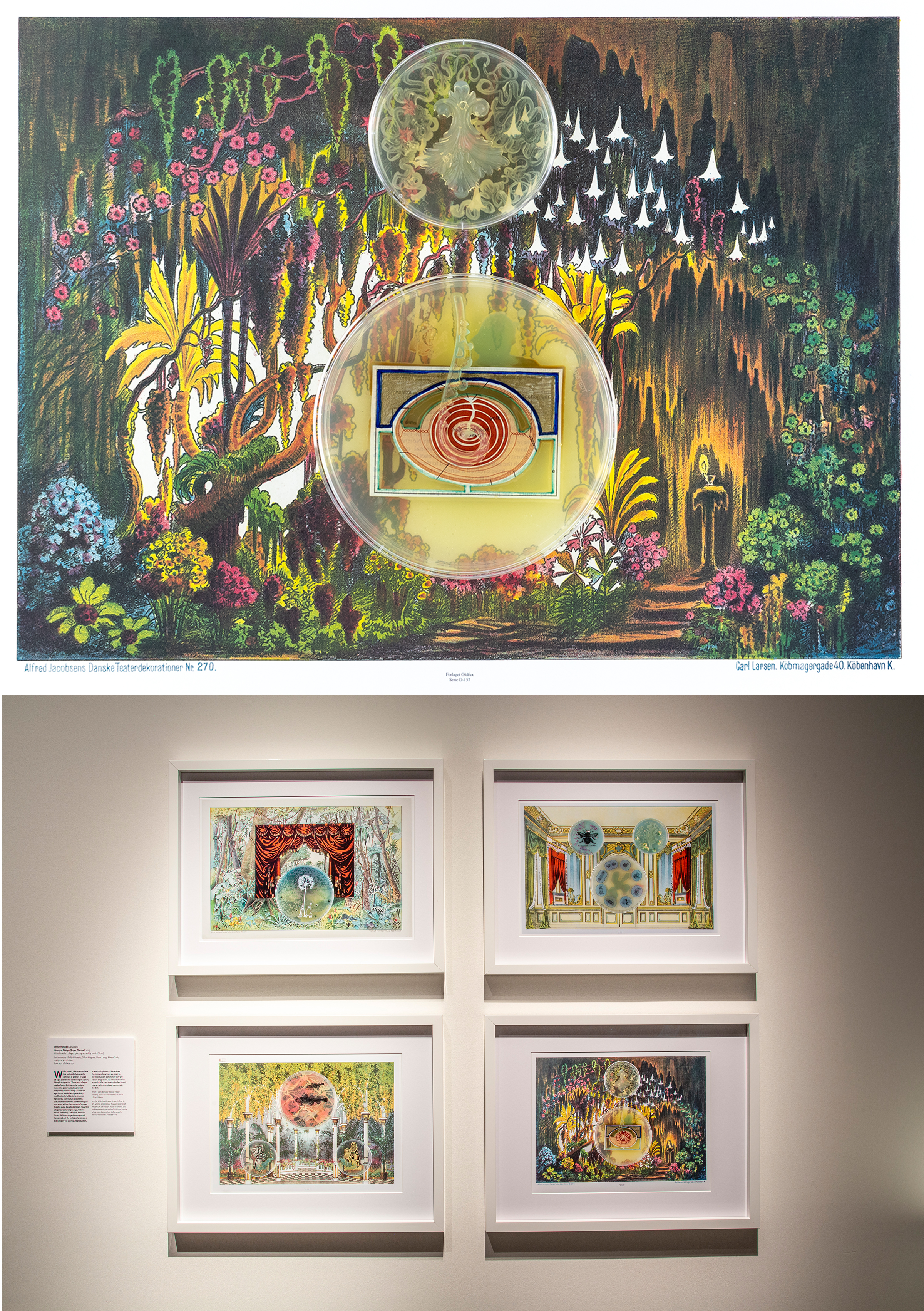
Jennifer Willet, Baroque Biology (Paper Theatre) (2018). Images by Molly Renda (top), Matthew Gay (bottom), courtesy of the Gregg Museum of Art & Design.
Errorarias: Bipolar Flower Enrichment (2018)
Adam Zaretsky
Artist Adam Zaretsky asks you to meet his “Bipolar Flowers” that are growing in the Errorarium. The artist describes the plants as “Bipolar (manic-depressive), Double Dipped, Zinc Fingered (ZF), GMO Arabidopsis thaliana plants.” The Errorarium is a device for exploring the gamification of the forced genetic errors that may predictably or unpredictably appear in chamber-grown, zinc-fingered botanica. The interactive installation is an enrichment terrarium that houses plants and subjects them to tests for photosynthetic and sonic engagement. The light and sound synthesizer has many dials that allow visitors to alter the environment of the growing organisms. The artist explains that the Bipolar Flowers must be contained, so they are grown, displayed, and publically entertained in the Errorarium. These plants have been “whole genome fracked” in a bipolar duet of two artificial transcription factors (activating and repressing) competing for the 524 GTA GAG GAG binding places on the Arabidopsis genome. These genes are regulated up and down according to the chance play of falling activation and repression domain inserts, claiming limited space in the plant’s resultant bipolar disorder: mood (behavior), energy (physiology), and ability to function (development). By changing the variables on the Errorarium, those interacting with the artwork are making the experiment non-repeatable and hard to utilize. Do you think you are enriching or stressing the organisms in the Errorarium with your mediated entertainment? What is the difference between enrichment and stress? These plants were created in the lab of Bert van der Zaal (in collaboration with David Lourier and Neils van Tol), but their future genetic expression can be influenced
by visitors.
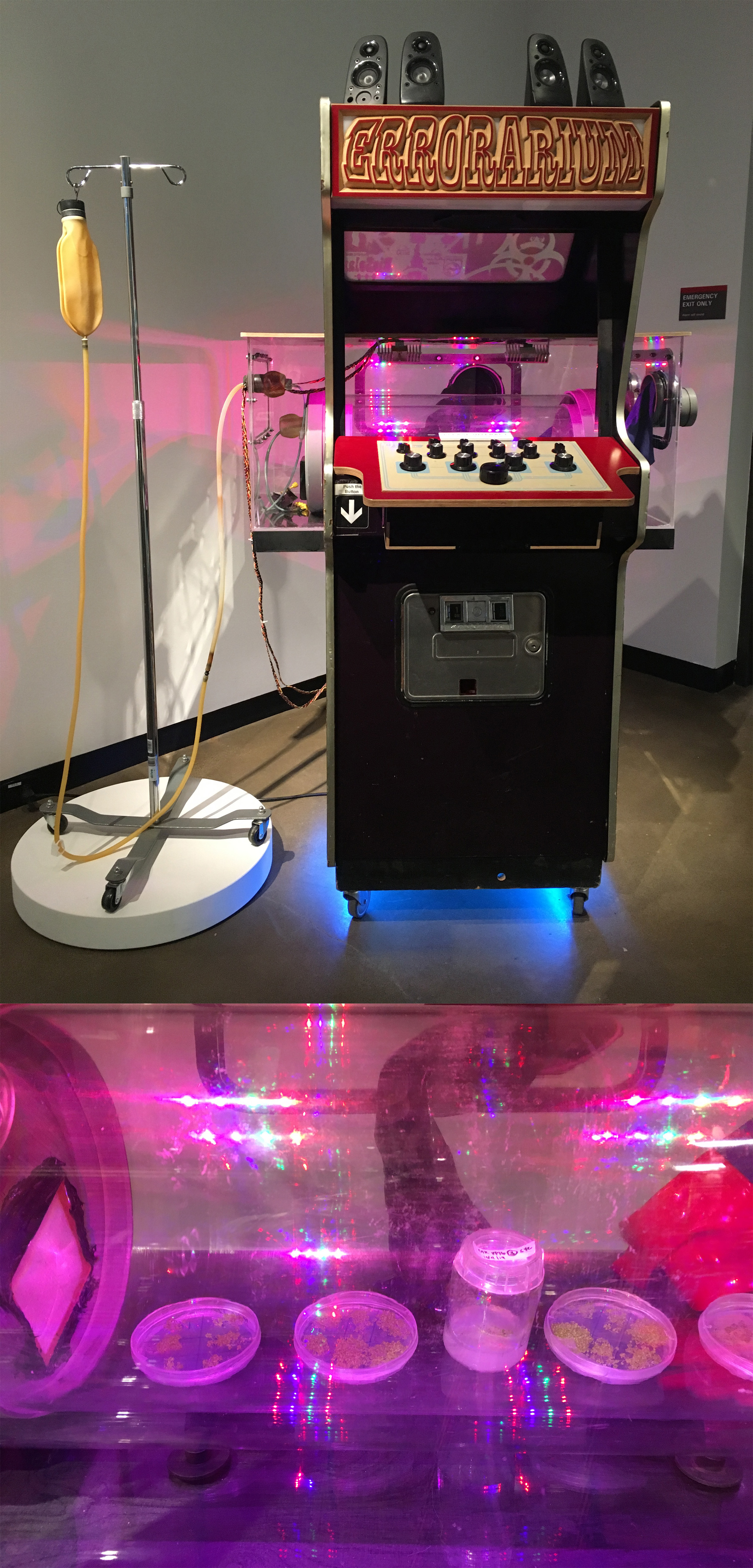
Adam Zaretsky, Errorarias: Bipolar Flower Enrichment (2018). Images by Molly Renda, courtesy of the Gregg Museum of Art & Design.
Acknowledgments
Many thanks to the artists who shared their work for this gallery. Special thanks to photographers Molly Renda and Matthew Gay, as well as the Art’s Work team, including the Genetic Engineering and Society Center’s Fred Gould, Todd Kuiken, Patti Mulligan, and Sharon Stauffer; North Carolina State University Libraries’ Molly Renda, Chris Vitello, and Chris Tonelli; and Roger Manley, Mary Hauser, and the staff of the Gregg Museum of Art & Design. A complete catalog of the show, including images of the corn maze, Molly Renda and William H. Dodge’s From Teosinte to Tomorrow, at the NCMA is available here.
